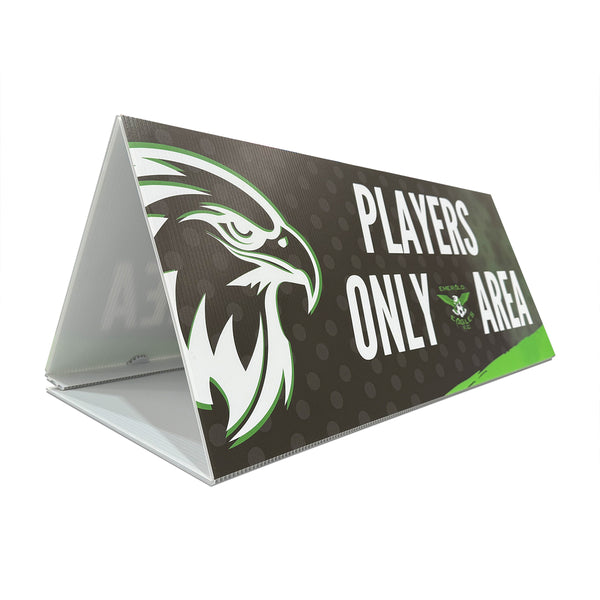What Is Large Format Printing and How to Use it for Advertising?
What Is Large Format Printing and Why Is It Important?

What is large format printing and how does it work?
If you want to raise the bar for outdoor advertising, large banner printing (also known as large format printing) is the way to go. This printing technique manages to take your marketing ventures a step further just by existing. It is a bold way to display your brand and attract your target audience.
Without even realising it, large format printing is already a significant feature of your life. Its most prominent examples are visible on the streets, highways, and even in the countryside in the form of billboards, hoardings, posters, and vehicle graphics.
That means you can reach your audiences virtually anywhere if you invest in it. There are many benefits of large format printing, and we explain all of them in this article. We also give you an insight into how it works and printing methods associated with it.
Let’s begin.
The Basics: What Is Large Format Printing?

What does large format printing mean?
Large format printing or wide format printing signifies printing big-fonts and large graphics onto sizeable rolls of printing paper (or other materials such as vinyl sheets). We need specialised printing equipment to run this operation.
Wide-format printing is useful for accommodating large-scale printing projects.
In advertising, this refers to a collection of advertising formats that are visible from a distance. They range from large posters, store displays, large format banners, exhibition signs, and wall panels for trade show booths. Building wraps and billboards are other popular items that require large format printing.
Despite popular belief, large format printing is not a new phenomenon. Printing presses and advertising companies have been using it for over two decades. With time and advancement in technology, the benefits of large format printing are becoming more accessible and versatile.
Therefore, most companies prefer it as their go-to printing method for outdoor, indoor, and trade show advertisements.
How Much Does Large Format Printing Cost?
The final price can vary from project to project, considering the different variables in use. You should consider everything while calculating the cost. It includes graphic design size, substrates, ink, and turnaround time. In addition, the amount of material required for printing and the type of advertising format can drastically change the cost.
For instance, a hoarding for a construction site will cost more than a banner for your shop.
The best idea is to contact your supplier and go over the necessary details. If you decide to work with us, you can ask for a free quote before finalising the project.
How Does Wide Format Printing Work?
Typically, wide format printers have a maximum width of 18-100 inches. It is much larger than standard printers you use at work and at home. The size of the printer in use depends on the dimension and material of your advertising project.
You need to finalise the dimensions and type of advertisement before moving to the printing process.
Here is the rundown of the three main steps of large format printing:
1. Choose the Substrate:
After selecting an advertisement format, you have to choose the substrate (or material to print on). Large format printing is doable on a variety of surfaces. Like, paper, vinyl, fabrics, canvas, plastics, and wood. Specialised printers can also work on metals and wood.
2. Select the Dimensions:
You must decide the exact size, shape, and graphic design required for your advertisement. We program these instructions into the printer, so it creates accurate, high-resolution printouts.
3. Printing Process:
The wide format printer sprays ink on the substrate by following a coded-pattern that matches your design. These printers usually use UV lights to speed up the drying process. That way, you can use your large format designs hot off the printer.
The overall time required to print something depends on the specifications of the project. Be sure to ask your vendor for an estimated timeline if you want to place an urgent order.
What Are the Benefits of Large Format Printing?

Caption: Vehicle advertising becomes easier with large format printing.
Large format printing is the best choice for branding and advertising when you need to attract more crowds. There are many benefits of large format printing for different industries.
You can use it to promote your brand indoors and outdoors without any issues. The large-scale designs and graphics are another factor that increases the importance of wide-format printing.
Here is a closer look at its most common advantages:
1. It Is Versatile
Unlike other printing methods, large format printing has an extensive range. You can use it to print billboards, hoardings, exhibition displays, retails signage, banners, wraps, posters, etc. That too on vinyl, canvas, wood, or metal depending on your needs.
2. It Is a Cost-Effective Solution
Large format printing is a long-term advertising tool. You can print a timeless graphic that works all-year-round. It is also highly durable, and it covers more space than standard-sized advertising material (i.e. flyers, small flags, and A4-sized posters).
The best part, you can use it twice or thrice when you wish to decorate your exhibition stand.You have the decision to choose designs for the modular exhibition booth and custom booths. Large format printing looks great on both mediums.
3. It Boosts Brand Awareness
Owing to its size and striking graphic designs, this type of advertising is a crowd puller. You manage to promote your business with one hoarding/sign by placing it in a high-traffic position. They are also more visible than flyers and memorable than brochures.
That means you can maximise your real-world presence with custom-designed large format printed advertisements.
In other words, you get to save money, improve brand recognition, and play with your advertising styles with one printing process. Its durability and is another advantageous factor for businesses on a budget.
The Essential Elements of Large Format Printing
Now that we have answered your question about 'what is large format printing', we should move to other aspects of this printing method. For knowing the basics is not enough for advertisers.
You should learn the nitty-gritty details to make the right decisions.
Here are some frequently asked questions about wide format printing:
1. What Kind of Materials Do We Use for Large Format Printing?

As mentioned earlier, large format printing is very versatile. You can do it on an assorted range of materials depending on your marketing budget and goals. Commonly used substrates include vinyl, paper, wood, fabric, plastic, and even metal. The key is to ensure that your selected material fits the carrier of your vendor’s printer.
You can ask this beforehand to receive high-resolution products.
2. What Is the Best Resolution for Large Format Printing?
Large format printing is supposed to be high on quality and resolution. The importance of wide formatting will diminish otherwise.
That is why choosing the correct DPI resolution (dots per inch or pixel per inch) is essential. The standard formula is to multiply 100 dpi with the size of the final product.
For example, when you order a 30x60 print, your image size should be 3000x6000 pixels at 100 dpi. You can also ask your vendors to show you samples from their archive. That way, you can select an image size that works for both them and you.
3. What Is CMYK?
CMYK is a colour model, which refers to standard ink plates inside a printer. Each letter stands for one of the four basic shades on the ink plates(i.e. Cyan, Magenta, Yellow, and Black). The ink in the CMYK colour scheme is subtractive. That means that its colour tone becomes darker when you blend them.
We often refer to this four-colour printing process as CMYK printing.
4. What Is RGB?
RGB is a standard colour model for producing colours on screen. It comprises of two primary colours red and blue along with a secondary shade (green). It is an additive colour scheme, where the colours get lighter when you merge them.
5. What Is The Difference Between RGB and CMYK?
RGB and CMYK are both colour palettes for mixing colours in graphic design. The main difference between them is their use. RGB colours are ideal for digital design and graphics, as we use them to combine and produce colours on screen.
Alternatively, CMYK is a colour mode for printing products. Wide-format printers come with pre-built CMYK ink plates that mix colours to create the right shade of ink for your graphic design.
6.What Is Bleed? Why Is Bleed Important in Printing?

Bleed is the short form of full-bleed printing. It is a printing technique, which prints designs slightly larger than the printing material. That means that the ink goes all the way to the edge of the sheet, leaving no white spaces. Adding a bleed section to your print ensures that there are no white strips at the edge of your printed copy.
This technique is especially crucial for print work that has coloured backgrounds and graphics. It also works well for printing copies that need trimming/cutting to match the preselected dimensions. Without it, your larger format printed products will look below average. Such poor quality products could negate the benefits of large print formatting.
7. How Do You Add Bleed in Advertising?
Adding bleed to your design required you to calculate the bleed margin according to the surface area of the printing material. The bleed section’s cut off point is a minimum of 0.25 inches. It could still result in a white line if you are not careful.
The standard procedure is to set the bleed section to 0.125-0.05 inches across the four corners of your design.
For example:
If you have a printing sheet of 12×6.5 paper, your final print size should be 12.125×6.25 inches. Some printing companies might have their variables. Be sure to verify and modify those before placing your order.
Besides setting the right bleed size, remember to choose the correct design orientation. Also, remember to position the main elements at the centre. This way, they remain prominent and have a lesser chance of being present outside the cut line in the print.
8. How Do You Determine Bleed Size?
The minimum bleed section should be approximately 0.125 inches (3mm) outside your page’s final size. You should calculate the size of the trim when you are determining the size of your bleed.
Lastly, when you get these dimensions right, you manage to optimize your large format printing process. This information serves as your base to design different and unique advertising materials.
In a Nutshell
Overall, large format printing is an excellent way to advertise your business. The benefits of large format printing include adaptable printing techniques and multipurpose use. With the right dimensions, bleed printing and resolution, your printed products will stand out in public.
We hope that this guide has answered all your questions on what is large print format printing and its many requirements. Find out more in Outdoor Vs. Indoor Advertising: Which One Is More Effective.
Are you ready to go big? We cater to your indoor and outdoor advertising needs with customised large format printing solutions. Browse through an assorted range of options!




